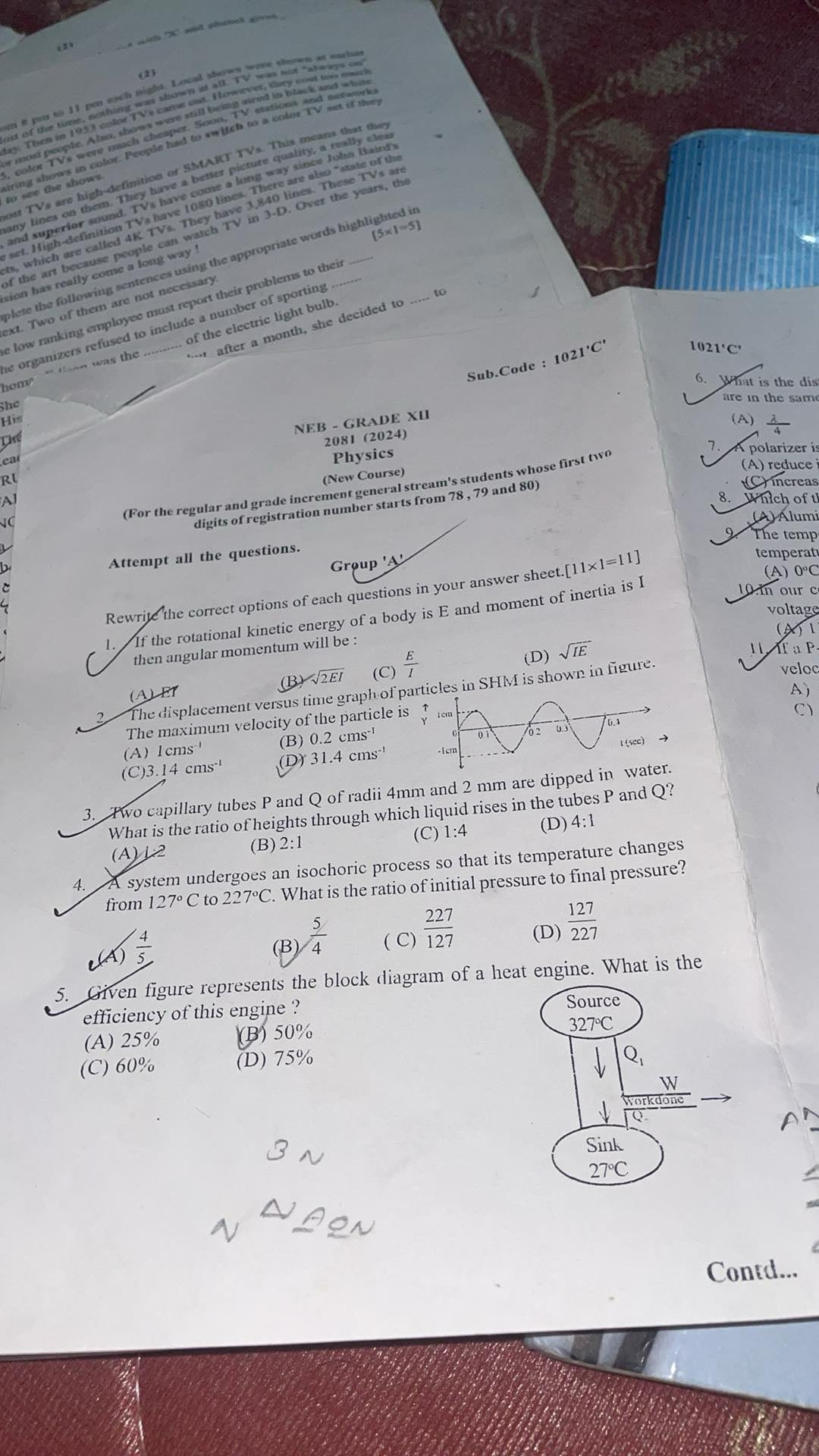1. If the rotational kinetic energy of a body is E and moment of inertia is I, then angular momentum will be: A) EI B) sqrt(2EI) C) E/I D) sqrt(IE) 2. The displacement versus... 1. If the rotational kinetic energy of a body is E and moment of inertia is I, then angular momentum will be: A) EI B) sqrt(2EI) C) E/I D) sqrt(IE) 2. The displacement versus time graph of particles in SHM is shown in figure. The maximum velocity of the particle is: A) 1 cm/s B) 0.2 cm/s C) 3.14 cm/s D) 31.4 cm/s 3. Two capillary tubes P and Q of radii 4 mm and 2 mm are dipped in water. What is the ratio of heights through which liquid rises in the tubes P and Q? A) 1:2 B) 2:1 C) 1:4 D) 4:1 4. A system undergoes an isochoric process so that its temperature changes from 127°C to 227°C. What is the ratio of initial pressure to final pressure? A) 4/5 B) 5/4 C) 227/127 D) 127/227 5. Given figure represents the block diagram of a heat engine. What is the efficiency of this engine? A) 25% B) 50% C) 60% D) 75%

Understand the Problem
The image contains a set of multiple-choice physics questions, likely from a high school or early college level exam. The questions cover topics such as rotational kinetic energy, simple harmonic motion, capillarity, isochoric processes, and heat engines. We must extract the questions and present them in clean text.
Answer
1. $\sqrt{2EI}$ 2. $31.4 \text{ cms}^{-1}$ 3. $1:2$ 4. $\frac{4}{5}$ 5. $50\%$
Answer for screen readers
- (B) $\sqrt{2EI}$
- (D) $31.4 \text{ cms}^{-1}$
- (A) $1:2$
- (A) $\frac{4}{5}$
- (B) $50%$
Steps to Solve
- Question 1: Rotational Kinetic Energy and Angular Momentum
The question relates rotational kinetic energy ($E$), moment of inertia ($I$), and angular momentum ($L$). The formula relating these is $E = \frac{L^2}{2I}$. We need to solve for $L$.
-
Solve for L $E = \frac{L^2}{2I}$ implies $L^2 = 2EI$. Therefore, $L = \sqrt{2EI}$.
-
Question 2: Simple Harmonic Motion (SHM) - Maximum Velocity
The maximum velocity ($v_{max}$) in SHM is given by $v_{max} = A\omega$, where $A$ is the amplitude and $\omega$ is the angular frequency. From the graph, the amplitude $A = 1$ cm. The period $T = 0.2$ s. Therefore, $\omega = \frac{2\pi}{T} = \frac{2\pi}{0.2} = 10\pi \approx 31.4$ rad/s.
-
Calculate max velocity $v_{max} = A\omega = (1 \text{ cm})(10\pi \text{ rad/s}) = 10\pi \text{ cm/s} \approx 31.4 \text{ cm/s}$.
-
Question 3: Capillary Action
The height ($h$) to which a liquid rises in a capillary tube is inversely proportional to the radius ($r$) of the tube, i.e., $h \propto \frac{1}{r}$. Therefore, $\frac{h_P}{h_Q} = \frac{r_Q}{r_P}$.
-
Calculate Ratio Given $r_P = 4$ mm and $r_Q = 2$ mm, the ratio $\frac{h_P}{h_Q} = \frac{2}{4} = \frac{1}{2}$.
-
Question 4: Isochoric Process
In an ischoric process, volume is constant, and $\frac{P}{T} = \text{constant}$. Therefore, $\frac{P_1}{T_1} = \frac{P_2}{T_2}$, which means $\frac{P_1}{P_2} = \frac{T_1}{T_2}$. We are given $T_1 = 127^\circ C = 127 + 273 = 400$ K and $T_2 = 227^\circ C = 227 + 273 = 500$ K.
-
Calculate Pressure Ratio $\frac{P_1}{P_2} = \frac{400}{500} = \frac{4}{5}$.
-
Question 5: Heat Engine Efficiency
The efficiency ($\eta$) of a heat engine is given by $\eta = \frac{\text{Work done}}{\text{Heat input}} = \frac{W}{Q_1}$. From the diagram, the source temperature is $327^\circ C = 600$ K and the sink temperature is $27^\circ C = 300$ K. The maximum possible efficiency (Carnot efficiency) is $\eta = 1 - \frac{T_2}{T_1}= 1 - \frac{300}{600} = 1 - \frac{1}{2} = \frac{1}{2} = 0.5 = 50%$.
- (B) $\sqrt{2EI}$
- (D) $31.4 \text{ cms}^{-1}$
- (A) $1:2$
- (A) $\frac{4}{5}$
- (B) $50%$
More Information
The questions cover fundamental concepts in mechanics, thermodynamics and heat. Be sure to know your formulas and how to apply them.
Tips
- Forgetting to convert Celsius to Kelvin for thermodynamic problems.
- Incorrectly applying the formula for SHM maximum velocity.
- Reversing the ratio of radii in the capillarity problem.
AI-generated content may contain errors. Please verify critical information